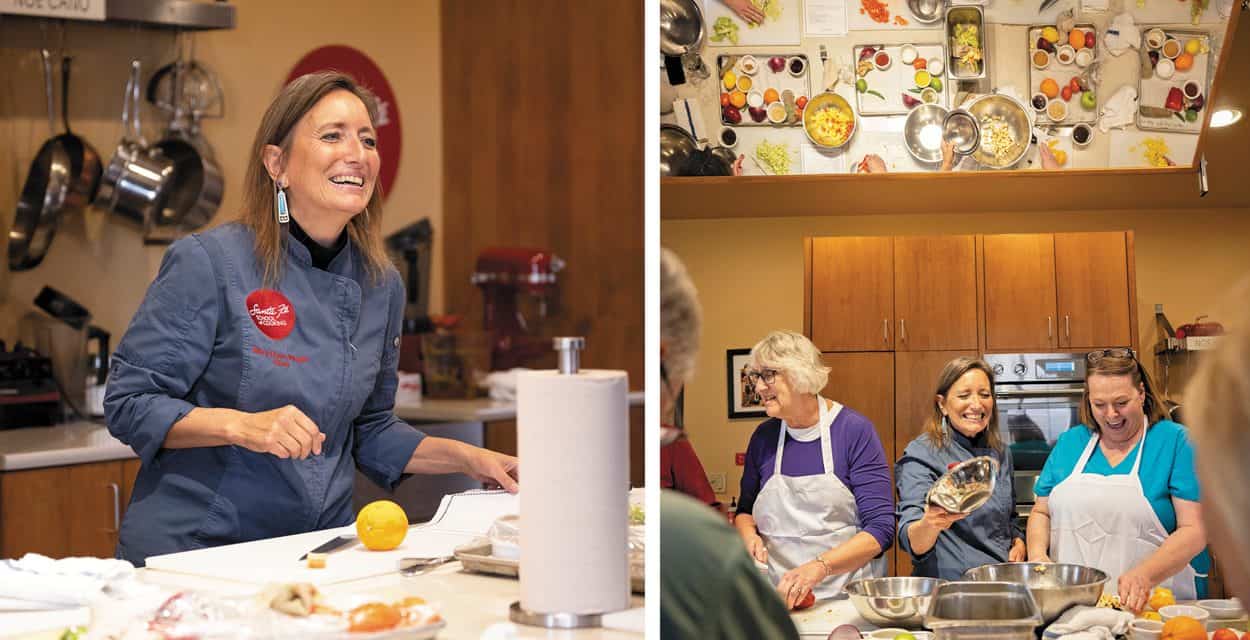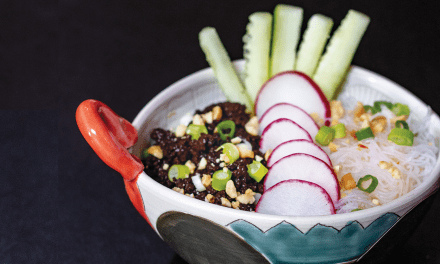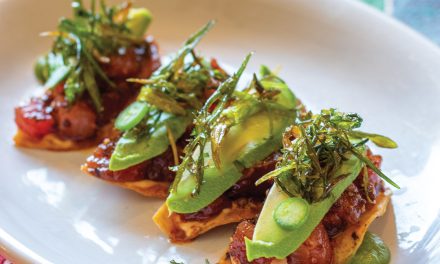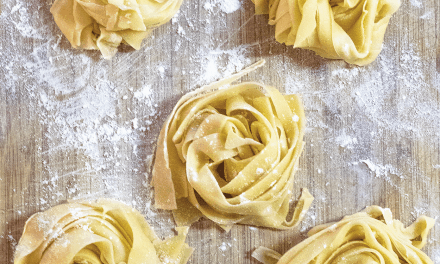New Mexico Nuts Featured at Santa Fe School of Cooking
By Lynn Cline · Photos by Douglas Merriam

Chef MaryDawn Wright instructs students at the Santa Fe School of Cooking.
The New Mexico piñon is a small but mighty nut, with deep roots in the high desert of the Southwest. Prized for its sweet, buttery taste, this versatile nut has been consumed by Native people for centuries, as well as by Spanish settlers, homesteaders, and other more recent arrivals to the region.
For Ancestral Puebloans, Diné (Navajo), and other Indigenous peoples, they were a staple and a power snack, as piñons are rich in protein and healthy fats. Once the Spanish settlers arrived some four hundred years ago, they incorporated piñons into their traditional recipes, both savory and sweet. Cleofas M. Jaramillo’s 1942 booklet, The Genuine New Mexico Tasty Recipes: Old and Quaint Formulas for the Preparation of Seventy-Five Delicious Spanish Dishes, describes an empanada made of ground beef, raisins, spices, port, and piñons.
Today, this little fruit of the Pinus edulis (New Mexico’s official state tree) is beloved by locals, who carry on the old tradition of gathering piñons from pine cones that have fallen off the trees in summer and fall and cracking open the hard shells with their mouths. Piñons are equally popular in area restaurants of every kind, making their way into appetizers, entrées, and all kinds of desserts. In fact, New Mexico Apple Pie with Green Chile & Piñon was the most requested recipe from the former Pie Lady of Pie Town, Kathy Knapp. Fernando Olea of Sazón, who this year won the coveted James Beard Best Chef: Southwest award, added piñons and pecans to the signature mole he created to commemorate Santa Fe’s four hundredth anniversary.
At the venerated Santa Fe School of Cooking, students learn to make delectable piñon shortbread in the New Mexican Vegetarian class, a recent addition to the many Southwestern and other classes this acclaimed cooking school has offered for more than thirty years. The class menu includes plant-based versions of classic New Mexican dishes such as hongos adovados—a mushroom version of carne adovada—but the piñon dish takes the cake. “Everyone’s blown away by the shortbread,” says Chef MaryDawn Wright, who created both the vegetarian class and the recipe for the cooking school. “Shortbread is good, but when you have the added sweetness and the richness of the piñon, it just takes the shortbread to another level.”
The cooking school incorporates piñons in other recipes too. “We make a great piñon nut butter and use piñon nuts in one of our moles,” says the school’s director of operations, Nicole Curtis Ammerman.
Pecans are another popular nut at the cooking school. This is only fitting since New Mexico is one of the largest pecan-producing states in the country, thanks to an abundance of sunshine. Pecans are grown on more than forty-five thousand acres, mostly in the southern part of the state. Heart healthy and full of nutrients, pecans have a sweet flavor, which makes them perfect for pies, but they taste great in a wide range of dishes.

“We use a lot of red chile pecans in our salads, and we make blue corn pecan pancakes in our Southwest Brunch class,” Ammerman says. The red chile pecans are a simple and satisfying combo of sugar and chile that coats the pecans, creating a delicious snack as well as a tasty addition to salads. “You get this spicy sweetness and nutty flavor,” says Wright. “We make that a lot at the cooking school.” The pecans are so popular that they’re available to buy in the school’s shop and its online market.
While mastering the flavors of New Mexico at the Santa Fe School of Cooking, students also learn about the history of the ingredients that have long played a role in regional cuisine. “The mission at the cooking school has remained constant from the beginning and that is to celebrate and promote the rich and historic traditions and food of Santa Fe,” Ammerman says. Yet the school remains innovative. “Every year, our chefs contribute new menu ideas that we offer during the slow season, January through March,” she says. “We call these bonus classes and they are offered at a heavily discounted price.” These popular classes fill up mostly with locals, who help the school decide which new classes to add every year.
“In addition, when we have a chef with a specialty, we encourage them to add in some classes to highlight this,” Ammerman continues. “For example, Chef MaryDawn Wright recently retired as the corporate executive chef from Sabra, so she did a Mediterranean-themed class. Molly Mix was hired to work in the shop, but she is a trained pastry chef, so she has started doing more baking classes for us. So you can see, it is all very organic.”
Wright, who has worked as a chef around the world, is thrilled to share her knowledge with her cooking school classes. “I have a degree in anthropology and I love looking at recipes and seeing the culinary history behind them, the adventure the ingredients took to get here,” she says. “For example, I love bizcochitos. They’re history in a bite. So following how the New Mexico ingredients came here—a lot of the ingredients traveled the Spice Route from China to the Middle East, up into Africa, and then came into Spain with the Moors—people are amazed. They just don’t have any idea of the history behind New Mexico cuisine.”
In a class with Wright, students might learn about piñons from around the globe. “When I worked for Sabra, I did a study on pine nuts from different parts of the world,” she says. “There are different flavor profiles. The ones from New Mexico have a more wild flavor, so they’re a little more intense and buttery. The ones from the Mediterranean are larger and have a more nutty flavor and less of a sweet, fatty flavor.”
In a nutshell, there’s a lot to discover about New Mexico tree seeds at the Santa Fe School of Cooking, which celebrates thirty-three years this December. Through classes, restaurant walking tours, culinary boot camps, and other offerings, guests can learn everything there is to know about foods of the Southwest, from soup to nuts.
125 N Guadalupe, Santa Fe, 505-983-4511, santafeschoolofcooking.com

Lynn Cline
Lynn Cline is the award-winning author of The Maverick Cookbook: Iconic Recipes and Tales From New Mexico. She's written for Bon Appétit, the New York Times, New Mexico Magazine, and many other publications. She also hosts Cline’s Corner, a weekly talk show on public radio’s KSFR 101.1 FM.












